

We are all familiar with website addresses (called URLs formally) e.g. https://www.infotex.uk/blog/?cat=1#top
Have you ever wondered what that actually means?
In this article we’re going to take one apart and explain each component.

https://
https:// is the protocol segment of a URL. Taken literally it means hyper text transfer protocol secure
Contrary to some belief that the web is an entirely American invention, HTTP as a protocol was invented by Britain’s own Sir Tim Berners Lee and his team back in 1989 as a very simple, lightweight protocol for transferring simple textual documents with minimal formatting (hence the hyper text name) across a network of computers.
There are other protocols which may be seen around the Internet, examples are mailto (email), ftp (file transfer protocol), tel (telephone number).
At the time of the web’s inception, it was inconceivable to think that it would be used for purposes requiring security as it was designed to allow academics to share papers. Also consider that back in the 1980’s encryption carried a massive processing overhead and legal challenges so it was simply ignored and some of the architects of these early protocols have since said that this was the biggest mistake made at the time.
The s of https stands for secure and was formally specified by Netscape in 2000 as part of the Secure Sockets Layer (SSL) that Netscape Navigator pioneered although its use didn’t become ubiquitous until around 15 years later having overcome a number of legal challenges such as the USA initially deeming encryption to be a munition thus illegal to export without licence, indeed encryption officially still requires a government licence for use in China today!
Many browsers now hide the protocol to simplify the view for users considering it to be superfluous nowadays.
HTTP has indeed transformed enormously from those early days as it has evolved through version 1.0 to 1.1 (which allowed multiple files to be downloaded back-to-back) and latterly version 2 (which allowed multiple files to be downloaded concurrently) with version 3 just starting to reach production, removing many of the low level performance bottlenecks.
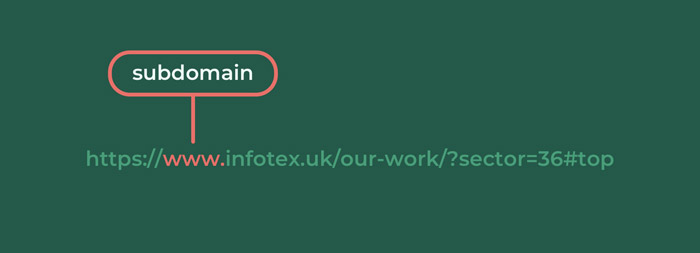
www.
By standard deviation most sites on the world wide web start with www. although from a purely technical reason this could be anything you like and you may see some sites use multiple subdomains for e.g. https://shop.
This section is often called a subdomain as it has been delegated by the domain (see next entry) as a child of itself and this subdomain is actually a DNS record or host name that at the most basic level is used to convert a friendly name into a server’s IP address. By passing through the subdomain and domain as part of the HTTP request it allows the server to identity which site and SSL certificate should be served to the viewer.
There is indeed some new technology on the horizon called “encrypted client hello” which will allow even this to be encrypted to avoid third parties even knowing what subdomain you’re visiting.

infotex
We have talked about domains before (https://www.infotex.uk/guide-domain-names/) but in short a domain is the part which you can personalise by choosing a combination of letters and numbers (and limited symbols like -) to use to distinguish your business. Domain rights are rented by the year typically 1-9 years at a time and the price for that rent depends on the domain extension (see below) with some premium extensions such as .xxx costing over £100 per domain per year.
DNS (Domain Name System) operates primarily at the domain name level allowing you to set nameservers, these control the records used to “point” a domain name to a server’s IP address(es), email server or similar by adding host records.

.uk
All domain names have an extension which is basically the top level of the DNS component.
At a technical level all .uk domains (for example) trigger a lookup to the governing body of .uk who will in turn supply the nameservers for the domain lookup (as mentioned above).
A lookup for www.infotex.uk is actually performed as 3 (or more) separate lookups because your PC will initially lookup who controls .uk, it will then turn to their server and ask who controls .infotex and then turn to their server and ask what server www refers to.
Much of this information is of course stored in memory of your PC or ISP’s DNS server in reality to avoid repeated time consuming lookups having to go around the world.
Domains were traditionally either Generic Top Level Domains (GTLD’s) such as .com / .net / .org or Country Code Top Level Domains (CCTLD’s) such as .co.uk / .fr / .eu
In recent years the governing body ICANN have opened up the market allowing businesses to setup registries under their chosen name, for e.g you can use the .bentley top level domain to find out more about the premium car maker Bentley although the cost and requirements for doing so rule out all but the biggest of businesses like Bentley, Amazon and Google.
In the UK the government has charged an independent body called Nominet with the task of overseeing all .uk domain names, Infotex are proud to be members and tag holders at Nominet meaning that we are able to take direct control of your .uk domain rather than having to refer to third parties, we are also able to help influence some of the policies around how these are overseen.
Infotex are naturally also able to register and control most other classes of domain such as .com’s for our clients.
Different domain extensions have different rules so, for example, to register a .eu domain you must provide details of your office at a location within the eu (which of course excludes the UK now).
When you see mentions of .to or .ly etc which are today commonly used in shortcuts it can be fun to ask yourself what country you are actually looking at (hint .to is Tonga and .ly is Libya)

/our-work/
This optional component is commonly used as the page or part of a site that you are viewing. Traditionally it would contain a filename extension such as .html to indicate that the response is Hyper Text Markup Language to be rendered by the viewers browser although nowadays while still present in the code, in many cases the extension is now dropped from display and all content returns an invisible header containing the same data encoded as a “MIME” type to offer more flexibility and be more user friendly.
The list of valid paths are set by the site owner and can even include unicode characters to represent foreign letters rather than being restricted to the traditional a-z format.

?
With the advent of “friendly URLs” as above, these are seen less often but many path segments (see above) that you enter today are actually converted into query(strings) by the web server without the user even realising.
A querystring is made up from sets of parameter pairs (see below) and when combined with the ? to identify their start forms the query. This is an optional extra component intended to be a user controlled component allowing users to provide a custom combination of keys and values that help to customise the display of the page, typically used in conjunction with server-side code to interpret their meaning.

sector=36
In the case of our website’s case studies, sector=36 is used to identify that you wish to filter to see just our ecommerce work, change that value 36 to 40 and you’ll see all our articles about B2B clients.
Parameters work in key & value pairs. A URL can have multiple parameter sets but each must have a unique key (sector in this case) and when there are multiple they are separated by an & (e.g. sector=36&q=design).
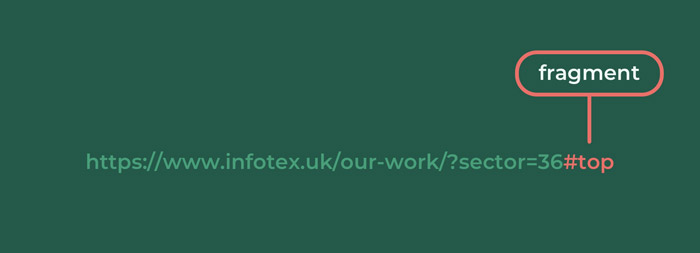
#top
The final part of a URL which is again optional allows the user to designate which part of a page they wish to see. Going back to the foundation of the web when viewing lengthy academic papers it was helpful for a reader to be able to use these like a bookmark to quickly get to chapter 10 (for example) and entering the fragment triggers the browser to scroll to that part of the page.
In modern usage it can also be a trigger for interactive events such as show and hide a page element (the answer to an FAQ for example).
So now that you know what makes up a URL when you’re next navigating a site you will have a much better understanding of the “magic” that your computer is doing behind the scenes to provide you with the information at the click of your mouse or tap of your mobile screen as it’s pretty impressive really and the result of decades of research and evolution.
Big or small, data takes up valuable storage space. And once physical storage like hard drives are full, all that data needs to be stored somewhere. This is where the cloud and cloud storage solutions come in. It’s online, on-demand and on the rise globally — so what is the cloud?

The cloud isn’t a place, but a name for the collective online, on-demand availability of services and applications. A global network of remote servers supports and hosts the cloud and allows access to storage wherever you are in the world. Tools like Microsoft OneDrive, Google Drive & Dropbox are great examples of cloud data storage that you’re possibly using already. However, systems exist in the cloud to make processing this data easier — systems such as Software as a Service (Saas) applications, like Zoom, Microsoft 365 or Google Workspace.
Such systems can be split into categories:
Traditional servers are bulky, take up physical space and need advanced cooling, leading to a bigger electricity bill as well as more square footage in your business. By switching to cloud computing and storage, you can save space and money while minimising your environmental impact. But where is the cloud, exactly? Your data is held in one or more data centres, and there are many different ones owned by large companies around the world. Google uses 40 data centre regions globally, Microsoft uses more than 200 centres as of 2023 but Cloudflare has a presence in over 300. The quantity and availability of data centres help the cloud to work as a fast, reliable tool for data storage and processing around the world.

Holding their share of the world’s online data is a big responsibility for all data centres. And for business customers, it’s crucial to know where that data is held and how it is used. We’ve explored cybersecurity in a previous blog, and some of these measures also apply to protecting the cloud. But what specific protections exist to keep the cloud safe? In the UK, the government’s National Cyber Security Centre (NCSC) explains 14 distinct cloud security principles, including:
These security principles give an easy-to-follow framework for any businesses using, accessing or storing data in the cloud. Encrypting data is another huge security aspect for anyone using cloud storage.
The cloud is infinitely flexible and provides businesses with a scalable model for data storage. So even if your needs change, there is always enough data storage in the cloud. As long as you have a reliable internet connection, with appropriate encryption and authentication to keep customer data safe, the opportunities are almost endless.
Keep following our easy data series for more insights.
Data and keeping it safe go hand-in-hand. And today, more of the world is online and more data is being created than ever before. In the second blog in our series covering all things data, we’re looking at the world of cybersecurity and discovering the impact it has on us all. Whether your data is big or small, national, international, business-specific, or personal, cybersecurity is an area that helps to keep everyone safe.

The classic image in the movies is of cybersecurity defenders and attackers playing cat and mouse in front of screens with rapidly scrolling text. While there is a degree of truth to this image, cybersecurity is a much broader sphere and one that we all have a role to play within.
There are many different programmes and tools under the rapidly expanding cybersecurity umbrella. In the UK, the government’s National Cyber Security Centre (NCSC) defines cybersecurity as “how individuals and organisations reduce the risk of cyber attack.” Cybersecurity is as much a mindset as it is a collection of tools used to achieve it.
When we talk about protecting data, this naturally includes ensuring the protection of the devices and the services we all use to process that data. Most tech users will find their data is spread between smartphones, laptops, desktops and servers making it hard to keep track of. This is all against the uneven playing field where an attacker only needs to find one weakness in any of those to be successful, whereas the defender needs to keep every one of them 100% secure all the time.
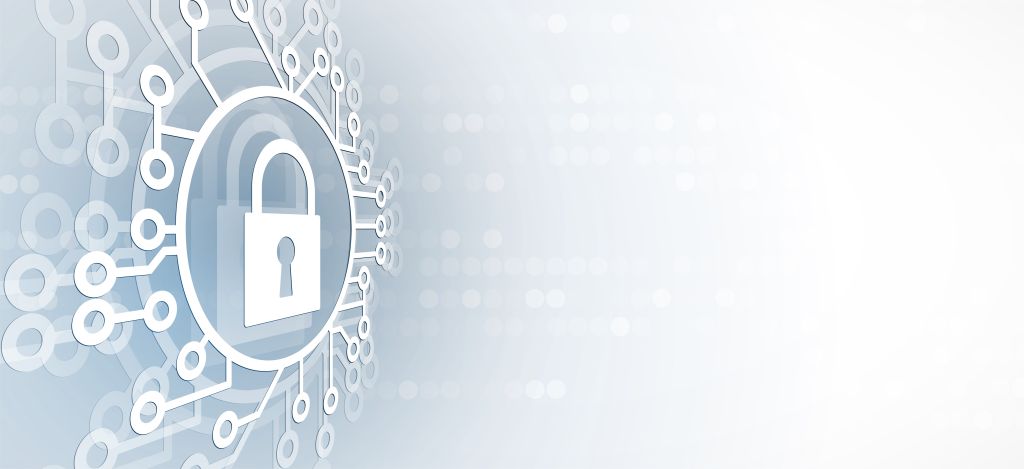
According to IBM Security, the average cost of a data breach in the UK is £3.2 million, proving that data — and the cost to put a breach right afterwards — is a highly valuable commodity and a huge responsibility to hold. You only have to search for high-profile cyber attacks and you can quickly find news of organisations of all kinds and sizes falling victim to cybercrime. Ransomware can attack the smallest organisation or the largest government body, and they each risk being held liable for large sums of money payable both to the attacker and to put right any harm done to the individuals whose data was leaked so it’s easy to see why cybersecurity is so crucial.
It’s not only the cost factor that makes data breaches so dangerous — your brand is on the line. Personal data is essentially a currency for brands and businesses, given in exchange for trust. And when that trust is broken, it can be hard to regain and can affect your business for a much longer period than resolving the actual breach.
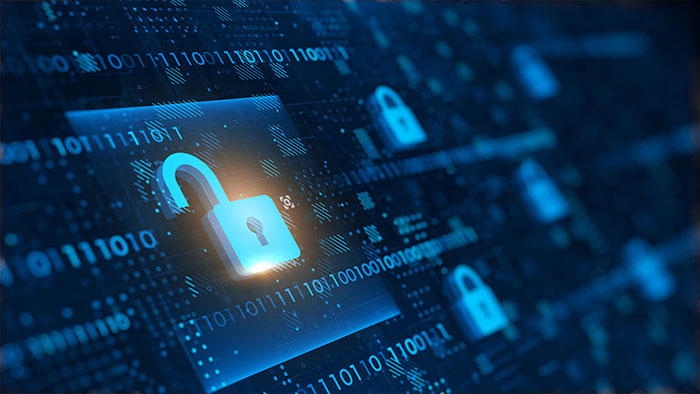
Right now, it’s estimated that 328.77 million terabytes of data are produced every single day. Customers trust organisations with their personal information, also called personally identifiable information, or PII. Think of everything you share with an online retailer when you purchase from them, all that data adds up to a lot of personal information. Your name, address, financial details and possibly more are all held on servers for them, and it’s the retailer’s responsibility to keep that data safe. By exposing that data to risk, it threatens both the individual’s privacy and the retailer’s livelihood.
And it’s not just online retailers that need to consider the risks of holding personal information. All businesses have a legal and ethical responsibility to protect their customers’, and employees, data. Organisations handling more sensitive information such as national security and health matters must ensure particularly strong data protection measures are in place. On a smaller but still crucial scale, solicitors, for example, can be hit by cyber attacks that prevent housing transactions from completing, having a real-world impact on people’s lives. The number of different kinds of data is countless, but it must all be protected.
What are the themes to watch? It depends on your industry, as the types of programmes and systems available are always changing and improving. Whether it’s technology such as firewalls, regulation such as GDPR or more, here are some trends to watch.
Keep following our blog series for more updates on the future of data, web development and more.
Updated February 2024
Google uses the page experience as part of their ranking algorithm, making it yet another factor to keep on top of to achieve a high position in the search results.
Google have grouped these under the title of Core Web Vitals, to provide a snapshot health-check of your site – but crucially it can use real visitor data.
Core Web Vitals are metrics introduced by Google to measure real-world usage of a visitor’s experience on a webpage. They comprise three primary measurements that are used to calculate the speed of the page and user interaction.
The Core Web Vitals are:
Not exactly snappy titles and not immediately obvious what they are. Strap in, here we go:
Largest Contentful Paint is simply the measurement of how long it takes a page-view to load for a real site user. So, from the point of clicking a link to seeing the site on your screen, Google tells us this should happen in under 2.5 seconds.

To analyse LCP, Google takes the largest content piece (be it text, video or image) to appear on the display. As the page changes in loading, Google shifts to the new main element. It progresses until when the page loads fully or the user starts interacting with the page. There are several elements that that can impact the loading speed, but the main factors for enhancing LCP include:
LCP is primarily going to be impacted by how your site was built in the first place, or what content you’ve added to it since, but from a site owner’s point of view making sure that images are correctly compressed for web use is important, either before uploading to the site or making sure the site itself is applying compression.
Cumulative Layout Shift calculates the visual stability of a page as it loads. Layout shift, also known as ‘layout jank’, appears when the information on the page keeps moving around despite the page appearing loaded. This is annoying, and can sometimes result in a user clicking the incorrect link.
The CLS score is calculated through multiplication of the display part that changed when loading by the interval it moved. Google’s recommendation is a score under 0.1, so only minimal elements move as the page loads.

Again, layout shift is going to be mainly influenced by how the site was originally built.
Largest Contentful Paint measures if the page is viewable. First Input Delay measures whether a user can interact with the page, such as clicking a link. Often a page can be viewable, but due to the loading of other items happening off-screen you can’t interact with the page.
Longer input delays tend to happen when the page is in the loading process and part of the content is already viewable but expecting to be interactive, since the browser is fully engaged in loading the remaining part of the page. The primary effort on developing FID is concentrated on quicker page loading.
Google rates a score under 100 milliseconds as Good for FID.

Implementing a site cache (such as Cloudflare) and reviewing slow 3rd party JavaScript can rapidly reduce your first input delay score.
From March 2024, Google will be using Interaction to Next Paint (INP) instead of FID (First Input Delay). INP assesses the responsiveness of using a webpage, such as clicking or a key press, and how long it takes for the user interface to update. When an interaction causes a page to become unresponsive, that is a poor user experience. INP observes the latency of all interactions a user has made with the page, and reports a single value which all (or nearly all) interactions were below. A low INP means the page was consistently able to respond quickly to all—or the vast majority—of user interactions.

PageSpeed Insights
The easiest way to view your vitals is via Google’s PageSpeed Insights. In the results, some sites will have a Field Data section, but this is usually only for larger sites.

If Field Data isn’t shown, you can still see a snapshot underneath from Lab Data. Note that running the report multiple times for the same page can get different results.

Google Search Console
For a more detailed view of Core Web Vitals, you will need to access Google Search Console. This will provide a graph of the number of pages with issues or improvements required over time, split between mobile and desktop.

Selecting the Open Report against these graphs then allows you to see what the issues relate to. Selecting any of the Types in the details section will show which pages are affected.

Google uses PageSpeed Insights as a tool for testing website performance.
A Google PageSpeed Score typically ranges from 0 to 100 with a higher score indicating better performance. The score is calculated based on how a page performs in terms of various performance metrics. The specific algorithm and weightings may change over time, but it generally takes into account factors like page load times, content rendering, and interactivity.
The PageSpeed Score is often linked to the user experience. A higher score usually correlates to faster loading and better user experience. Google and other search engines consider page speed and user experience when ranking pages in search results, so a better score can lead to improved search engine ranking and user engagement.
An overall Speed score is calculated by looking at the categories for each metric:
We could equate Core Web Vitals to emissions tests during your car’s MOT. It’s measuring multiple areas all designed to improve the quality of the environment or in this case the internet. As Core Web Vitals are now being used by Google as part of their ranking algorithm, for those sites wishing to stay on top of their search engine positions it’s going to be important to monitor them and make sure that your site stays in tip-top condition.

Many of the world’s major sporting events take place every four years such as international football tournaments, the cricket and rugby world cups and, of course, the Olympic games. Generally the summer Olympic games take place in leap years although since an end of century year is only a leap year if it is also divisible by 400 then the year 2100 won’t be a leap year even though it is an Olympic year. The last edition of the summer Olympic games was delayed by a year due to the Coronavirus pandemic which has clearly had a major impact on the business and technology worlds over the last four years.

The pace of technological change means that over the last four years there have been huge leaps in the development of artificial intelligence. The ChatGPT service was only launched in November 2022 but has rapidly gained awareness with the general public rather than just within the technical sector as had been the case with AI previously. We’ve already written a few articles on this topic such as AI Tools we are using but if you’re using February 29th as a way of thinking about how your business approaches the next four years then take the time to think about how you could integrate some AI into your processes.

If you’re not quite ready for AI yet then perhaps you might take a step back to consider other systems within your business. Something that might have worked well for you four years ago may now be starting to get unwieldy as your business grows. Security and availability of data is crucial to the success of a business and if you started out storing data in a spreadsheet such as Microsoft Excel now might be the time to consider whether that is still the best home for your business critical data.

In general many companies look to redesign or refresh their websites every 2-3 years so if your website hasn’t changed since the last leap year then it might be worth thinking about a refresh, we’re always happy to have a conversation about how we can help with that refresh process.
This leap day we hope you get the chance to take that step back from the day to day to look at the bigger picture for your business.
With Valentine’s Day approaching, we want to wax lyrical — not just for our loved ones, but for our beloved county of Suffolk and our clients within it. We are proud to have worked across the globe over the last 25 years, but nothing quite beats the feeling of working for our local clients and we love our ongoing relationships.
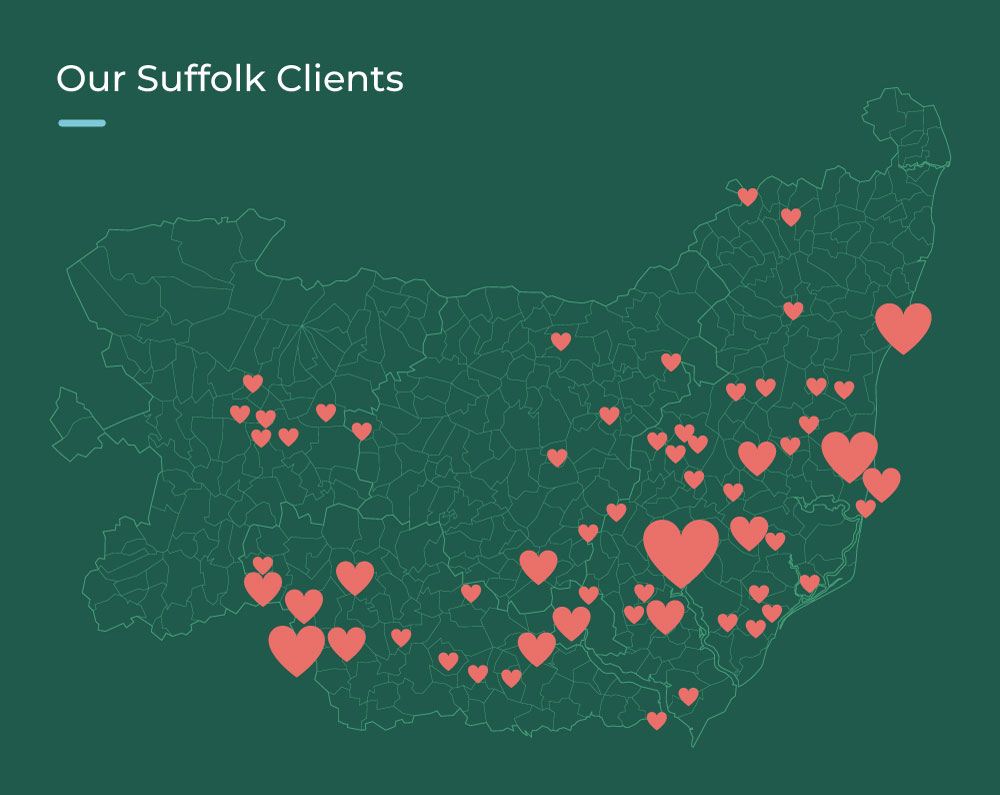
Here’s our love letter to a few of the local social enterprises and businesses we love working with, and continue to support.
Using their self referral system means you can show yourself a little love, as well as getting access to important resources for your physiotherapy needs. We love working with AHP on this platform. Its focus on user experience makes NHS healthcare that much easier to access for people both within and outside Suffolk.
A romantic walk in the countryside has nothing on Suffolk as it’s known for its diverse landscapes and history as well as Areas of Outstanding Natural Beauty.
Working with Green Suffolk, who have the aim of Creating the Greenest County, we are proud to have created their WordPress website. We also migrated their content across to the new site so they can continue to champion the local work they are doing, and provide resources for people keen to make a positive ecological impact in Suffolk.
Starting out casual and getting more serious, our relationship with Denbury Homes started by creating a quick website as they rebranded from Hopkins & Moore. We worked fast on our feet, helping establish the Denbury Homes presence online, and they were so impressed with the work created they changed their plans — retaining our work and using it as their future foundation of growth. Just like Denbury’s exceptional home builds, we are proud to show our exceptional development skills to match!
It’s not all about looks, and while keeping website designs simple we can also develop integrations behind the scenes to help showcase the best of a business. ACC Art Books are one of the world’s leading publishers and distributors of books relating to the arts and visual culture. Established in 1966, ACC also represents nearly 100 premium publishers worldwide and are based here in Suffolk.
In redeveloping their website, we built a bespoke API to help bring the work across 4 sites into a unified portal. We are not just a pretty face but have some strong development power. Also the perfect site to check out for an unexpected Valentines gift….
What’s Valentine’s Day without a little sauce? And what’s better than Scarlett & Mustard’s range of condiments, dressings, jams and conserves?
They produce a range of delicious sweet and savoury condiments and dressings from their base in Suffolk. With their bold branding we continue to support them with their website and we are some of their biggest champions!
Situated on the banks of the River Deben, Woodbridge Tide Mill Museum’s wheels have been turning for over 800 years. One of only two tide mills you can see at work, Woodbridge Tide Mill Museum is a charity who needed an up to date website that’s clear and accessible for its many visitors.
We love working in partnership and so far have enjoyed the work we are doing with SCA. Sharing knowledge and resources, even more so locally is valuable to us here at Infotex and with the SCA. Healthcare is an area we have over 25 years of experience in and are keen to help companies with anything relating from websites to systems and anything else digital.

So you’re thinking of a career in web development, but not sure where to start? We sat down with our Technical Director Christopher Waite to see what advice he’d give to aspiring developers.
Web development offers great flexibility in how you work, either freelance or salaried and almost every industry requires development in some capacity, meaning you have endless options to build a career to suit you.
With the ever changing landscape, there’s always new things to learn so you’ll have the opportunity to push yourself and grow your expertise. That said, here are a few tips to get you thinking and hopefully give you the confidence to start…
Data is the language of technology, and it’s something that we all use, add to, create and learn from every day. But what exactly is data, why is it important, how do we keep it safe and where is it stored? This new blog series from Infotex will explain it all and keep you up to date with the latest in the world of online data. But first, let’s start at the beginning with the big question.

When it comes to computing and websites, data is information. Put simply, data is every photo, video, sound and text in a computer, broken down into a string of numerical values called binary code. This code is made up of just two digits: 1 and 0. The smallest unit of data is called a bit, a portmanteau of ‘binary’ and ‘digit’. Then the next biggest is a byte, which is eight binary digits long. Data gets progressively bigger into megabytes and gigabytes, and then terabytes. Most computer users won’t need to think about anything bigger, but with an estimated 120 zettabytes of data generated in 2023, and predictions of 150% growth in 2025, it doesn’t hurt to be more familiar with larger types of data. A zettabyte, by the way, is equivalent to a trillion gigabytes. And just for fun, if one byte of data is a grain of rice, then a zettabyte is enough rice to fill the Pacific Ocean.
Enough of the measurements. Why is data so important? It’s the backbone of the internet, and with more of our lives and important files online than ever before, we must understand the importance of data and the impact it has on all our lives. The way we use, store and interact with data is always changing, and this blog series will explore data, cybersecurity, the cloud, and the future of data.
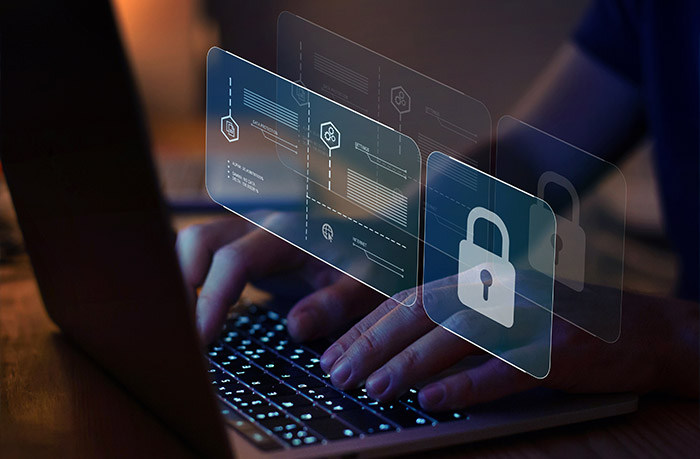
Cybersecurity is all about defence. Defending data, defending privacy, and defending all computers and technology against hacks and attacks. While greater connectivity via the internet is a huge advantage, it can also leave organisations vulnerable to cyber attacks. According to IBM Security, the average cost of a data breach in the UK is £3.2 million, proving that data is a valuable commodity. Not only that, but when organisations risk the safety of customer data, the reality is they will lose trust from a loyal customer base.
Cyber attacks come in many forms, and fraudsters are always looking for new ways to infiltrate even the safest systems. Three of the most common types of cyber attacks:
These attacks can leave an organisation out of business and the loss of customer trust is a potentially enormous blow to deal with. Keeping up with cybersecurity measures is crucial for all organisations to maintain their reputation and the future of their business.
While there are many different cybersecurity features to watch, these three are proving increasingly popular online.
We’ll be exploring cybersecurity in more detail in a future blog post, so make sure you’re following the series for more information.

The cloud isn’t a place, but a name for the collective online, on-demand availability of services — usually data storage and processing. A global network of remote servers supports and hosts the cloud and allows access wherever you are in the world. Tools like Dropbox, OneDrive, Microsoft Azure and Google Drive are great examples of cloud storage that you’re probably using already. Your data — which can include files, emails, or photos — are all stored in a physical location called a data centre, which can be anywhere in the world depending on your location. Google has 35 data centres globally, and Microsoft has more than 200 centres as of 2023. The quantity and availability of data centres helps the cloud work as a reliable tool for data storage around the world.
Knowing where your data is and how companies use it is key to keeping vital information and personal details private and safe. Where the cloud can get complicated is when the data privacy laws cross international borders, so it’s important to know which laws are keeping your data safe. In the UK, remaining GDPR-compliant while using cloud storage and cloud-based services can be a challenge. It’s a topic we’ll explore in more detail in a later blog.

No topic is complete without some frequently asked questions. And with a topic as complex as data itself, there are plenty of questions to explore.
Cloud storage is split over servers all around the world. In the UK, your data will be held in one of an estimated 517 centres currently. But it’s not only data centres that store information. Websites can store the smallest amounts of data, including cookies and user preferences. Your internet browser will store history, downloads, bookmarks and passwords. And your personal hard drive will store anything that you save to it, keeping your precious photos, work files and favourite music safe.
“Big data” is what it sounds like — it’s data that is simply too large to measure using traditional means. Big data can be described using three Vs: volume, velocity and variety. Huge quantities of data, known as data sets, are used on a large scale for data analysis to spot patterns, inform decisions, train algorithms, and even tailor targeted advertising.
We’d love to say a firm ‘yes’, but the answer truly depends on where your data is held, which organisations are responsible for looking after it, and where and how it can be accessed. Third-party access is a big issue in data security, and advances in AI are likely to have an impact on the way we store data securely in future.
For more FAQs and answers, follow the blog series for more information.
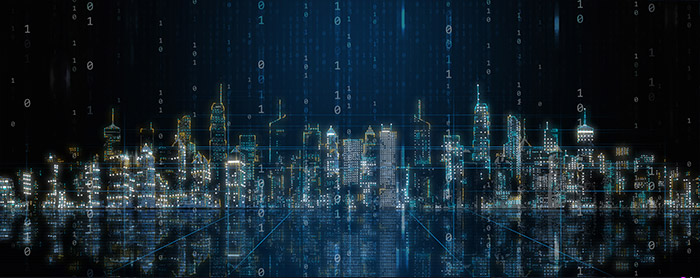
So what’s next for the future of data? With more interconnected devices thanks to the Internet of Things (IoT) and growing networks, the amount of data we’re producing is increasing at a rapid pace. The data market has been estimated to be worth $400 billion by 2030, which means we’re going to need a lot more security. Gartner has predicted that AI-enabled fraud will be a bigger threat by 2025, and said: “the consumerization of AI-enabled fraud will fundamentally change enterprise attack surface driving more outsourcing of enterprise trust and focus on security education and awareness.” This is a topic we’ll be coming back to in a future blog post, so follow us to find out more.
When we are working on a website or systems project we may use the terms “front end” and “back end” to describe what we’re working on.
The front end of a website or system is what the users interact with. That could be the images or text that they see on screen to describe a product or the buttons that they click to add something to their basket. The front end is what our designers have produced during their process of creating wireframes and visuals.
Once the designers have created the visuals for the site and the customer has signed them off the development team will move on to converting those designs into HTML (Hyper Text Markup Language) or JavaScript code which are languages used by web browsers to display content on screen and make that content interactive for users. The front end of the website is responsible for sending messages to the back end of the website based on actions that a user has taken e.g. adding a product to a basket or saving their delivery information.

The back end of a website or system is where the information used on the website is stored and processed. Usually there will be a database that holds the information and some code that responds to the messages sent from the front end. For a website project this is often a CMS (Content Management System) such as WordPress which comes with lots of pre-defined functionality and a database structure which we then add to in order to meet the specific needs of a particular project. For a systems project the team will generally create a bespoke back end for the project including writing code and creating a database to hold the information required.

For any website the front end and back end must work in harmony to produce the best outcome. A beautifully designed front end can still result in an unusable website for the client if the back end is too slow or fails to take the right action when a user tries to do something. Equally a smooth, quick back end will not be enough on its own to make a successful website if the front end doesn’t help users to do what they want to do, for example because the layout doesn’t work well on a mobile device.
At Infotex we aim to produce websites and systems that have well designed, mobile responsive front ends and efficient back ends to maximise the experience of users and the better the experience of the users the more likely they are to engage with the website and make a purchase or read the information you want them to.
This article is part of our blog series: Websites 101, lightly introducing and explaining important topics on everything to do with websites, including design, digital marketing, software, infrastructure and beyond.
Got a question you want answered as part of the Websites 101 blog series? Get in touch to let us know.
Every year I’ve hosted a quiz on the day of our Christmas party. Apparently, this year was “too hard”, but as it is the season of giving I’m posting it online so you can try it yourself, or test your office.
Quiz Questions 2023 [PDF]
Quiz Questions & Answers 2023 [PDF]
Rounds cover the last 12 months, items relating to royalty, band anagrams and more.
Featured questions:
Let me know how you get on.
How does Google see your website? What are your site’s top performing pages? Which keywords are people using to find your site? What’s needed to improve your website’s performance?
Google Search Console is the free tool that helps you get to the root of these questions. Here are the need-to-knows for understanding and making the most of the product.
Google Search Console is a free product designed to help website owners monitor the performance of their website in Google Search results.
Formerly known as Google Webmaster Tools, it helps measure organic search engine listings such as keyword rankings, as well as any issues reported by the search engine that can be used to improve the website’s performance.
The information provided can help a site owner understand how they’re doing in Google Search. It also informs anyone who directly works on the site – be that an agency like Infotex or site owners and administrators – how to troubleshoot issues and improve performance.
If you have a website with Infotex, then it is very likely that your site is already registered with Google Search Console. You can contact your Account Manager or the Support Team if you wish to be added as a user to the Google Search Console service.
Otherwise, sign up to Google Search Console to verify your ownership of your website and get going.

Once logged in to Google Search Console, you are presented with a left hand menu of sections including:
Overview: Provides a summary of your site performance and indexing in Google.
Performance Reports: Displays how many people saw and clicked on your site in Google Search, as well as your website’s average position in Google search rankings. This information can be seen for both keywords and for individual site pages, so it is an important tool for understanding the search terms people are using to find your site and the content that is being seen most in search results.
Page indexing: A report which shows all pages on your site that are known to Google, along with whether each page is or is not indexed in Google, and the reasons for this.
Page experience: This report isn’t about what some would typically associate with Google Search. Page experience reports on how “good” a page is in terms of other factors like loading speed and mobile experience. As Google’s ranking algorithms have become more and more sophisticated, these experience metrics have become more important for Search Engine Optimisation.

Google Search Console is a vital tool for any Digital Marketer for both troubleshooting and understanding a site’s performance. It’s well worth a look, even if you’re just wanting an overview of what keywords your site is being found for.
This article is part of our new blog series, Websites 101, lightly introducing and explaining important topics on everything to do with websites, including design, digital marketing, software, infrastructure and beyond.
Got a question you want answered as part of the Websites 101 blog series? Get in touch to let us know.
Black Friday is seen by many retailers as one of the biggest selling opportunities of the year. But is a Black Friday sale the right option for your business?
Since it was introduced to the UK by Amazon in 2010, Black Friday has become a much anticipated four-day long retail event, which sees retailers release big offers and discounts to mark the beginning of the Christmas shopping season. This year’s Black Friday falls on November 24th and is likely to be one of the largest ever, particularly for online sales.
But Black Friday is also associated with fuelling hyper-consumerism, irresponsible production and damaging smaller businesses who cannot compete with the discounts on offer from bigger retailers. The notoriety of the sales mean it is not uncommon to see false discounting, and even entire fake stores designed to catch the unsuspecting consumer.
Because of this, some big brands are choosing to opt out of Black Friday altogether, and 85% of independent retailers also boycott the event.
The brands doing Black Friday differently
For a number of years some socially and environmentally conscious brands have been boycotting Black Friday.
IKEA boycotted Black Friday sales last year, saying that they don’t do large sales because they strive to have the most affordable prices possible all year round. In the place of Black Friday, they are favouring their Green Friday initiative, which enables customers to get 50% off new items when returning an old item to the store through the Buyback & Resell scheme.
Patagonia, for example, does not participate in Black Friday in the usual way, instead committing to repairing clothes, buying used, and buying quality to improve sustainability and help tackle the climate crisis. For Black Friday 2011, the brand ran an ad in The New York Times highlighting overconsumption, and in 2016 donated 100% of Black Friday sales to grassroots organizations.
Skincare brand Deciem have opted to close down their website and store for 24 hours each Black Friday. Instead, they have a month-long sale as part of their ‘Slowvember’ campaign, to encourage consumers to take time to consider whether the product is necessary and the right product for them, instead of impulse buying, which can lead to waste.
Despite their hugely popular Boxing Day sale, Next has opted out of Black Friday since 2020. While they’ve never divulged the reason, the general thinking is that it is a push towards sustainability.
Boycotting Black Friday can actually help your business, communicating that you have confidence in the value of your product at full price and, in doing so, building trust with your customers.
However, Black Friday also has many positives: most importantly, sales are a valuable opportunity for consumers to purchase necessary items that are too expensive at full price.
Our advice is do what suits your business best. If you are going to participate in the nation-wide discount extravaganza, consider your offer and why you’re doing it, keeping your customer experience and business values in mind. Make sure you keep in touch with the wider team, including delivery companies, website hosting etc to make sure they’re geared up as well to support your promotion.
Discover how our team can help you on your journey.
Talk to us today